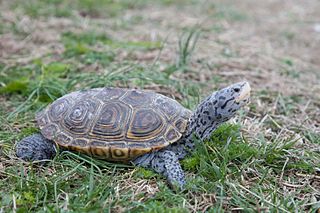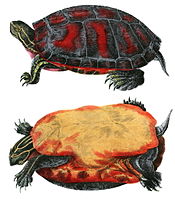
The red-eared slider or red-eared terrapin is a subspecies of the pond slider, a semiaquatic turtle belonging to the family Emydidae. It is the most popular pet turtle in the United States, is also popular as a pet across the rest of the world, and is the most invasive turtle. It is the most commonly traded turtle in the world.

Emydidae is a family of testudines (turtles) that includes close to 50 species in 10 genera. Members of this family are commonly called terrapins, pond turtles, or marsh turtles. Several species of Asian box turtles were formerly classified in the family; however, revised taxonomy has separated them to a different family (Geoemydidae). As currently defined, the Emydidae are entirely a Western Hemisphere family, with the exception of two species of pond turtle.

Trachemys is a genus of turtles belonging to the family Emydidae. Members of this genus are native to the Americas, ranging from the Midwestern United States south to northern Argentina, but one subspecies, the red-eared slider, has been introduced worldwide. Species under this genus are commonly referred to as sliders.

The razor-backed musk turtle is a species of turtle in the family Kinosternidae. The species is native to the southern United States. There are no subspecies that are recognized as being valid.

The Big Bend slider, also called commonly the Mexican Plateau slider and la jicotea de la meseta mexicana in Mexican Spanish, is a species of aquatic turtle in the family Emydidae. The species is native to the Southwestern United States and northern Mexico.

The Cumberland slider, also called commonly the Cumberland turtle and Troost's turtle, is a subspecies of pond slider, a semiaquatic turtle in the family Emydidae. The subspecies is indigenous to the Southeastern United States.

Mauremys reevesii, commonly known as the Chinese pond turtle, the Chinese three-keeled pond turtle, or Reeves' turtle, is a species of turtle in the family Geoemydidae, a family which was formerly called Bataguridae. The species is native to East Asia.

The northern red-bellied turtle or American red-bellied turtle is a species of turtle in the Pseudemys (cooter) genus of the family Emydidae.

The Jamaican slider, also known as the Cat Island slider, is a species of fresh water turtle in the family Emydidae. It is found in the Bahamas and Jamaica. As it is not currently found on any of the other surrounding islands in the region, it is assumed that the Jamaican slider was introduced from one of these countries to the other. Even though the popular theory was that these turtles originated from Jamaica, current geological evidence may suggest that they were in the Bahamas long before the native Taíno first went to the Bahamian islands. There is also evidence from archeological sites on San Salvador that the Taíno ate these turtles and transplanted them around the West Indies.

The northern map turtle, also known as the common map turtle, is an aquatic turtle in the family Emydidae. It is endemic to North America.

Terrapins are a group of several species of small turtle living in fresh or brackish water. Terrapins do not form a taxonomic unit and may not be closely related. Many belong to the families Geoemydidae and Emydidae.

The Yilan River (Chinese: 宜蘭河; pinyin: Yílán Hé; Wade–Giles: I2-lan2 Ho2) is a tributary of the Lanyang River in Yilan County, northeast Taiwan. It flows through Yilan for 25 kilometers.

The yellow-bellied slider is a land and water turtle belonging to the family Emydidae. This subspecies of pond slider is native to the southeastern United States, specifically from Florida to southeastern Virginia, and is the most common turtle species in its range. It is found in a wide variety of habitats, including slow-moving rivers, floodplain swamps, marshes, seasonal wetlands, and permanent ponds. Yellow-bellied sliders are popular as pets. They are a model organism for population studies due to their high population densities.

The false map turtle is a species of turtle endemic to the United States. It is a common pet species. Two subspecies are recognized, including the nominotypical subspecies described here.

D'Orbigny's slider or the black-bellied slider, commonly known in Brazil as tartaruga-tigre or tartaruga-tigre-d'água, is a species of water turtle in the family Emydidae. The species is found in southern Brazil, northeastern Argentina, and Uruguay. Two subspecies are recognized as being valid, Trachemys dorbigni adiutrix and Trachemys dorbigni brasiliensis.

Turtle farming is the practice of raising turtles and tortoises of various species commercially. Raised animals are sold for use as gourmet food, traditional medicine ingredients, or as pets. Some farms also sell young animals to other farms, either as breeding stock, or more commonly to be raised there to a larger size for subsequent resale.

The Nicaraguan slider is a subspecies of turtle in the family Emydidae. The species is indigenous to Nicaragua and Costa Rica.

Trachemys callirostris is a turtle in the family Emydidae found in Colombia and Venezuela.

The red-eared slider × yellow-bellied slider is an intergradation of a red-eared slider and yellow-bellied slider subspecies. Intergrade facial markings range from a yellow blotch behind each eye, which may join a yellow neck stripe forming a “C” figure when viewed from the left side to those with an almost indistinguishable amount of red in the eye blotch, to individuals that look similar to red-eared sliders with a red “ear” stripe that doesn’t join with a yellow neck stripe. In addition, the number of black blotches on the plastron varies in intergrades from two on the front scutes which is typical of yellow-bellied sliders, to a dark blotch on each scute which is typical of red-eared sliders. Intergrades are presumed to be omnivorous, but hatchlings and juveniles are more carnivorous than adults.


























